
Step-by-Step Guide to Perfect Korean Army Stew 2025
If you’ve ever wanted a one-pot Korean meal that’s bold, hearty, and full of umami, look no further than Korean Army Stew, also known as Budae Jjigae. This iconic Korean-American fusion dish blends spicy, savory, and cheesy flavors in a way that’s comforting, nostalgic, and perfect for sharing on cold nights. From tender tofu and chewy noodles to melty cheese and spicy broth, every bite is a satisfying journey of textures and tastes.
Whether you’re a beginner in Korean cooking or a seasoned foodie, this recipe is designed to guide you step by step, helping you create a restaurant-quality stew at home that’s sure to impress family and friends.
Why You’ll Love This Korean Army Stew
- Bold and Spicy: With gochujang, kimchi, and Korean chili flakes, this stew delivers heat with depth.
- Loaded with Texture: Firm tofu, savory spam, juicy sausages, mushrooms, and instant noodles make every spoonful interesting.
- Quick and Easy: Despite its complex flavor, it’s a simple one-pot recipe that takes less than 30 minutes to prepare.
- Customizable: Adjust the heat, protein, and toppings to suit your taste.
- Comfort Food at Its Finest: Cheesy, brothy, and packed with umami, it’s the ultimate cozy meal.
A Brief History of Budae Jjigae
Budae Jjigae, which translates to “army base stew,” has a fascinating history. After the Korean War, food scarcity was widespread. People near U.S. military bases began using surplus processed foods such as Spam, hot dogs, and canned beans, mixing them with traditional Korean ingredients like kimchi and gochujang.
This improvisational stew soon became a symbol of Korean resilience and creativity, evolving into a beloved comfort food that combines Western processed meats with Korean spicy, tangy flavors. Today, it’s enjoyed across Korea in homes, street food stalls, and restaurants, often served bubbling hot straight from a shallow pot.
Ingredient Highlights
Each ingredient in Budae Jjigae plays a critical role in balancing flavor, texture, and umami. Here’s what you need:
- Tofu: Firm tofu works best, adding protein and absorbing the spicy broth. Slice it thick enough to maintain texture.
- Spam or Canned Meat: Adds a savory, salty depth and authenticity. Cut into bite-sized strips for even cooking.
- Sausages: Traditional Korean sausages, hot dogs, or Vienna sausages all work. They bring juiciness and a familiar comfort-food flavor.
- Kimchi & Kimchi Juice: Fermented cabbage is essential for tang, spice, and umami. Don’t skip the juice—it intensifies the broth.
- Gochujang & Gochugaru: Korean chili paste and flakes provide signature heat, spice, and color. Adjust to taste.
- Instant Ramen: Absorbs the rich broth, creating slurp-worthy noodles.
- Cheese: Melted cheddar or American cheese adds richness, creaminess, and balances the spice.
- Mushrooms: Enoki or oyster mushrooms lend a soft, silky bite.
- Chicken Broth: Use low-sodium broth to control saltiness. The broth carries the flavor of all ingredients.
Optional Additions: Rice cakes, baked beans, or a poached egg can add texture and richness.
Pro Tips Before You Start
- Cookware: Use a wide, shallow pot. It helps present ingredients beautifully and ensures even cooking.
- Arrangement: Don’t stir the ingredients too much. Arrange tofu, spam, sausages, and vegetables around the edges for a classic, Instagram-worthy look.
- Adjusting Spice: Use less gochugaru or add more cheese to mellow the heat.
- Kimchi Juice: Essential for authentic depth. Substitute with rice vinegar if unavailable, but flavor may vary slightly.
- Extra Toppings: Sprinkle sesame seeds, green onions, or add an egg just before serving.
Step-by-Step Cooking Instructions
Step 1: Prepare the Sauce
In a small bowl, mix:
- 2 tablespoons gochujang
- 1 teaspoon soy sauce
- 1 teaspoon sugar
- 1 tablespoon gochugaru
- 1 clove garlic, minced
Stir until smooth and set aside.
Step 2: Arrange the Ingredients
In your wide shallow pot:
- Neatly arrange sliced tofu, spam, sausages, onions, green onions, and mushrooms around the edges.
- Place kimchi and kimchi juice in the center.
- Keep green onions and optional toppings aside for later garnish.
Step 3: Add Sauce and Broth
- Spoon the prepared sauce over the kimchi.
- Pour 4 cups of chicken broth evenly without disturbing the arrangement.
- This ensures all flavors infuse evenly during simmering.
Step 4: Simmer the Stew
- Bring the pot to a gentle simmer over medium heat.
- Cover with a lid and cook for 6–8 minutes until flavors meld together.
- Avoid vigorous boiling—it can break the tofu and noodles.
Step 5: Add Ramen Noodles
- Reduce heat to medium-low.
- Place instant noodles in the center, gently pushing them into the broth.
- Cook for 3–4 minutes or until tender.
Step 6: Finish and Serve
- Top with a slice of cheese and scatter reserved green onions and sesame seeds.
- Serve hot while bubbling for maximum flavor and comfort.
Serving Suggestions
- Steamed White Rice: Complements the spicy, rich broth.
- Kimchi or Scallion Pancakes: Crispy sides to balance flavors.
- Pickled Radish or Cucumbers: Cool down the heat.
- Korean Beer or Soju: Enhances the authentic experience.
- Extra Cheese or Eggs: For added richness and creaminess.
Variations & Substitutions
- Vegetarian Version: Omit spam and sausages; increase tofu, mushrooms, or add more vegetables.
- Extra Protein: Include thinly sliced beef, ground pork, or poached eggs.
- Extra Spicy: Add chili crisp or additional Korean hot pepper paste.
- Noodle Swaps: Udon, rice noodles, or even shirataki noodles for a different texture.
- No Cheese Option: Leave it out or use mozzarella for a different melty texture.
Storage & Leftovers
- Refrigeration: Store in an airtight container for up to 3 days.
- Reheating: Heat gently on the stove with a splash of water or broth.
- Note: Noodles will absorb the broth and soften further—still delicious!
- Freezing: Not recommended due to tofu and noodle texture changes.
FAQs
1. What is Budae Jjigae?
It’s a Korean stew combining traditional Korean ingredients like kimchi and gochujang with American processed meats like Spam and sausages.
2. Can I make it less spicy?
Yes, reduce gochugaru and chili paste or add more cheese to balance heat.
3. Do I need kimchi juice?
It adds authentic tang and depth, but rice vinegar or extra broth can substitute.
4. What sausages work best?
Hot dogs, Vienna sausages, or Korean-style sausages all work.
5. Can I make it in advance?
Prep ingredients ahead, but assemble and cook just before serving for best flavor.
6. Is it okay to mix everything together?
Yes! Mixing at the table is part of the fun and flavor experience.
Flavor Notes & Tips for Perfection
- Umami Depth: Kimchi juice, gochujang, and broth layers create a rich, savory taste.
- Balancing Spice: Cheese and mild broth balance heat without dulling flavor.
- Texture Variation: Tofu, mushrooms, and noodles provide soft and chewy contrasts.
- Presentation: Keeping ingredients separated until serving makes the dish more visually appealing.
Why It’s the Ultimate Comfort Food
Korean Army Stew combines spicy broth, chewy noodles, soft tofu, melty cheese, and savory meats in a single bowl. It’s perfect for family dinners, cold nights, or social gatherings, offering both flavor satisfaction and a fun, communal eating experience.
Final Thoughts
Budae Jjigae is more than just a meal—it’s a culinary story of Korean history, creativity, and comfort. Easy to make, highly customizable, and irresistibly flavorful, it’s a stew that brings people together, satisfying cravings for spice, cheese, and hearty goodness.
Try this recipe at home, add your favorite variations, and enjoy a bowl of steaming, cheesy, spicy, and nostalgic Korean Army Stew.


